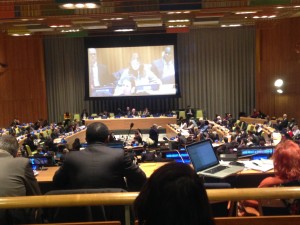 So here we are writing blogs about the SDGs, talking about how there are these indicators supporting targets, and targets supporting goals and goals that make up this giant 15 year plan – yet you might not even know what any of this means. First of all, you probably want to know the conference we are attending. The four of us, Jenna Farineau, Aura Silva, Makiko Yoshida, and myself, Kimberly Lopez, are attending the Post 2015 Sustainable Development Intergovernmental Negotiations.
So here we are writing blogs about the SDGs, talking about how there are these indicators supporting targets, and targets supporting goals and goals that make up this giant 15 year plan – yet you might not even know what any of this means. First of all, you probably want to know the conference we are attending. The four of us, Jenna Farineau, Aura Silva, Makiko Yoshida, and myself, Kimberly Lopez, are attending the Post 2015 Sustainable Development Intergovernmental Negotiations.
Let’s start with the definition of Sustainable Development. Sustainable Development can be loosely defined as meeting current needs without without compromising future generation capabilities. In 2000, 189 nations set eight goals, called the Millenium Development Goals (MDGs). These goals were:
1) Eradicate extreme poverty and hunger
2) achieve universal primary education
3) promoting gender equality and empower women
4) reduce child mortality
5) improve maternal health
6) combat HIV, AIDS, Malaria, and other diseases
7) ensure environmental sustainability
8) global partnership for development.
The mission was to allow 10 years for the member states to try to achieve these goals to some degree. By the end of 2015, these MDGs will expire, and we will be transitioning into the Sustainable Development Goals (SDGs) during the United Nation conference on Sustainable Development.
In preparation of the Sustainable Development Negotiations, there was an Open Working Group (OWG) that came up with suggested goals and targets. The OWG was limited to include only 30 representing spots. However, because multiple member States wanted to be involved, this did not stop multiple countries to ally together to take up one spot. Out of OWG, there were 17 goals and 169 targets drafted. A goal would be an overarching normative goal (what we would like to see happen broadly), and targets (how we can achieve that vision technically) fall below that. Indicators are ways of measuring the desired targets. There are several targets for each goal, and there may be more than one indicator per target.
During the negotiation, member states gave feedback on the SDGs that were presented and the way indicators should be established. Indicators are the basis to achieve the targets. Most of the member states talked about the three pillars that should be taken into account when creating indicators. The three pillars are of economic, social, and environmental concerns. Because these indicators are generally going to be set on a global level, member states want to make sure that it is taken into account the different circumstances every nation has in regards to these pillars.
A summary of the feedback:
- Most of the member states agree that there needs to be capacity building, in other words finding financial and technical support for less advantaged member states, especially the global south (technical term for developing or underdeveloped countries).
- Most of the member states agree that by January 2014, implementation should begin, meaning ___. The levels of implementation should be on national, regional, and global levels. In which the global levels will be set on a UN base. However, regional and national levels should be arranged by their prospective nations depending on their circumstances.
- Most member states agree there should be desegregation of data on all marginalized groups. Some of these marginalized groups that need to be treated in an equal manner should include indigenous groups, gender groups, disabled groups and different age groups.
- Member states call for transparency and report on progress of the High Level Group – which are technical experts that will determine which indicators should be created.